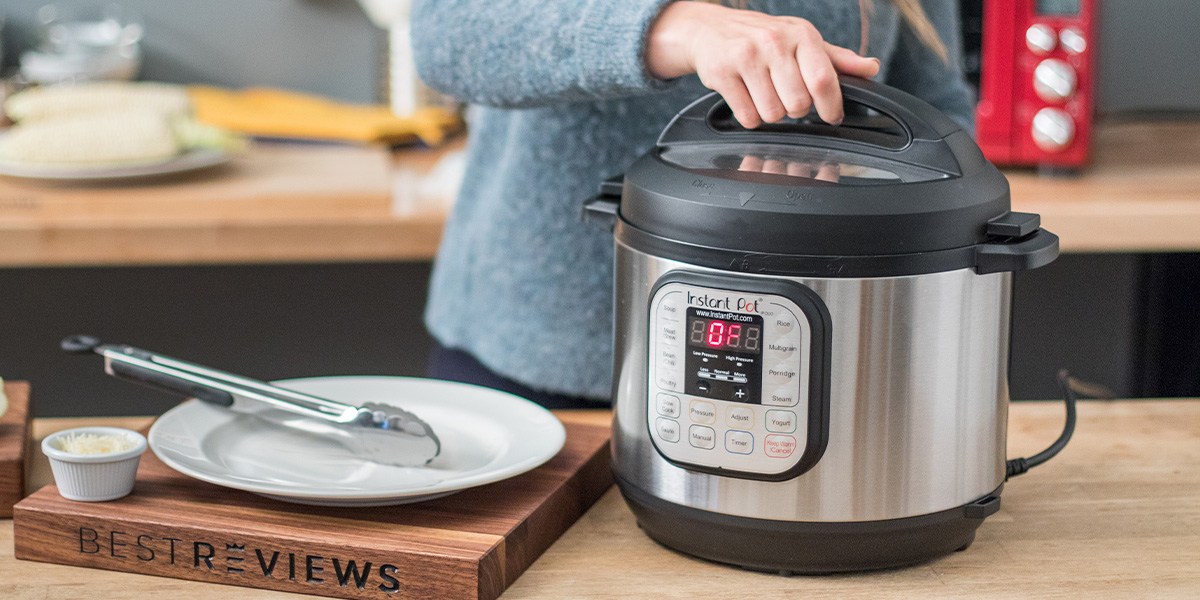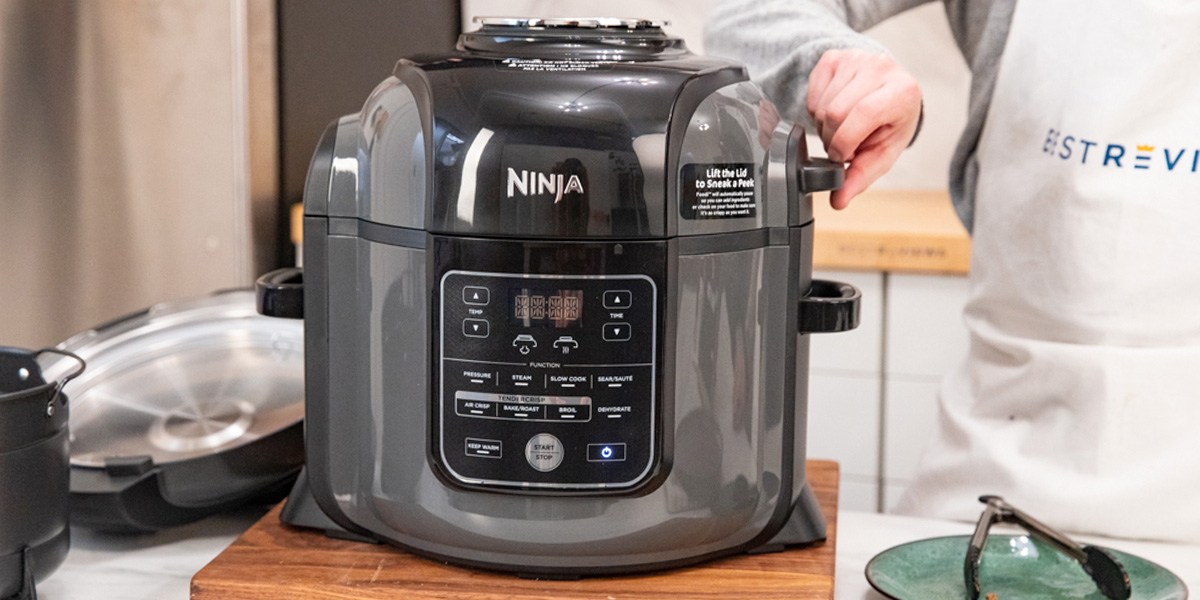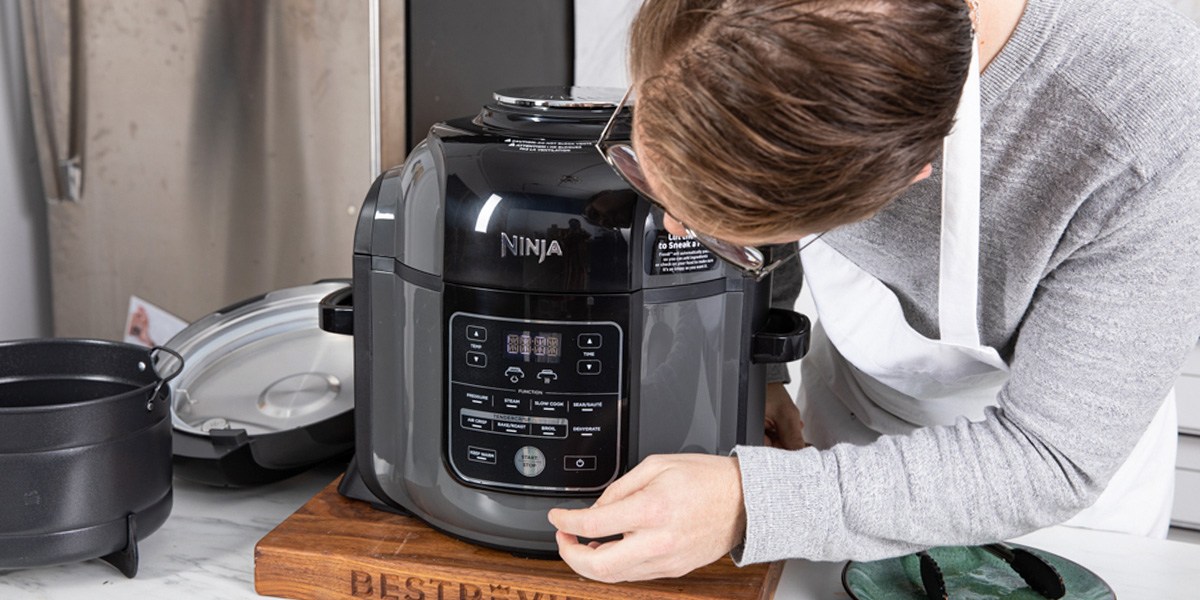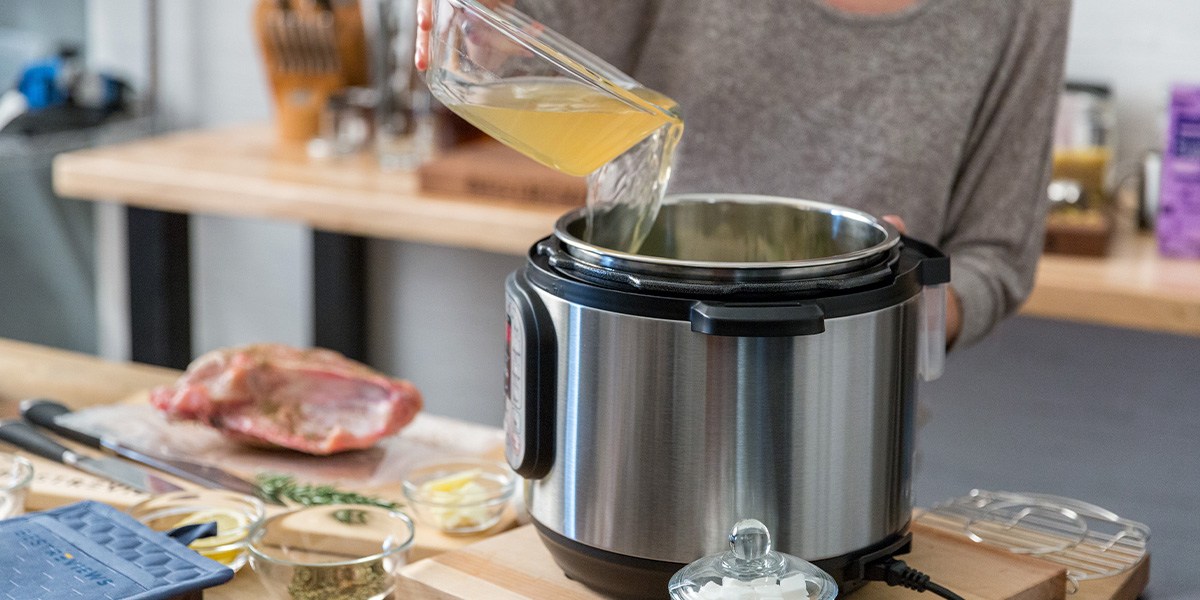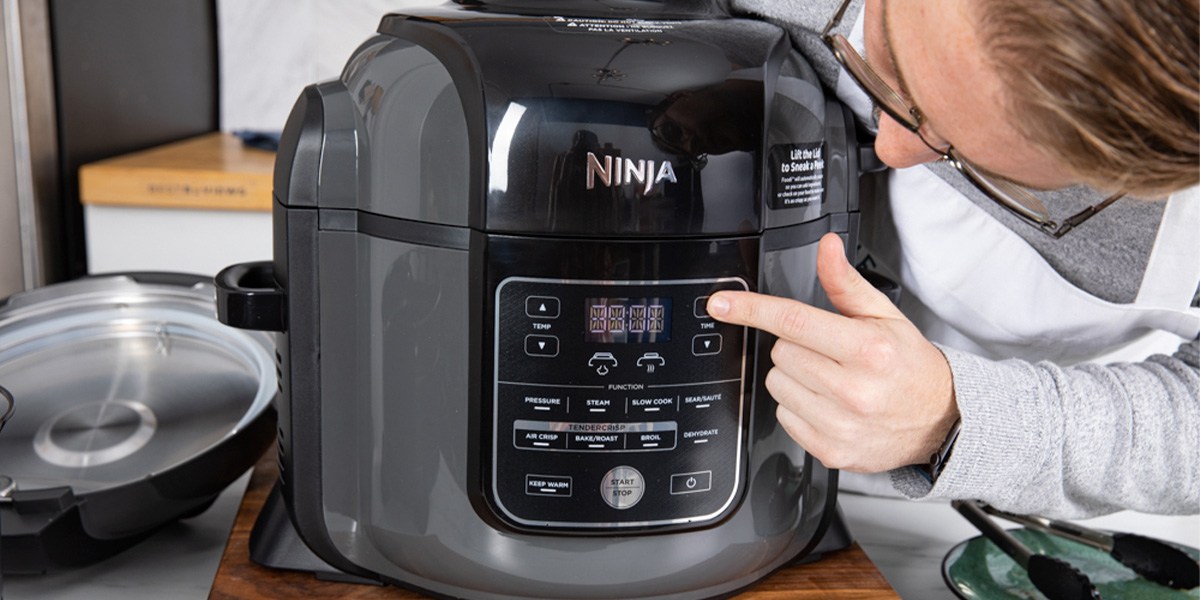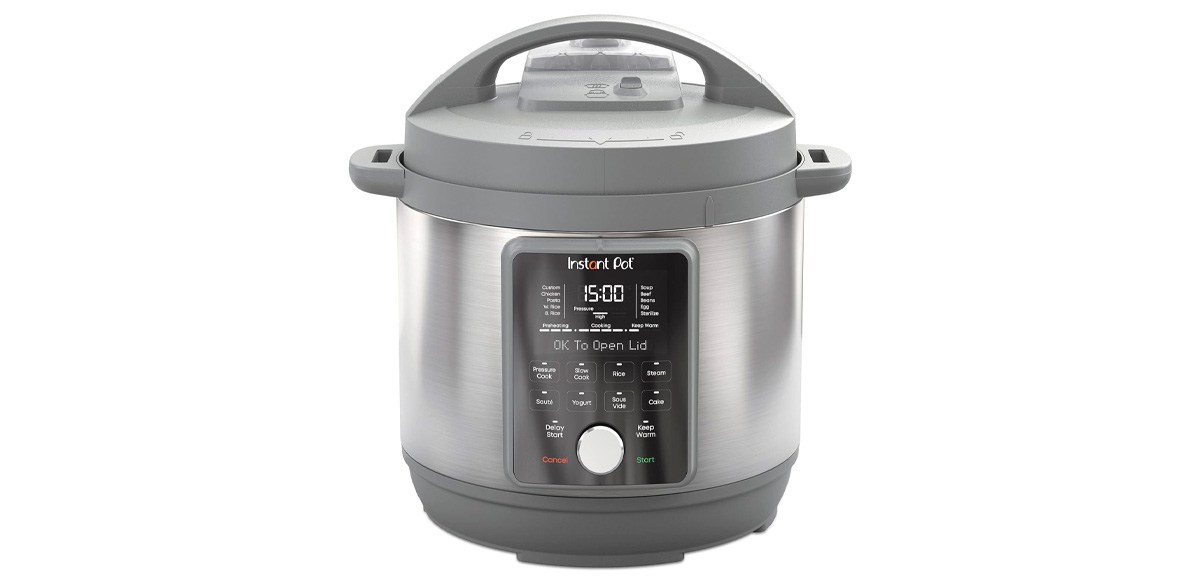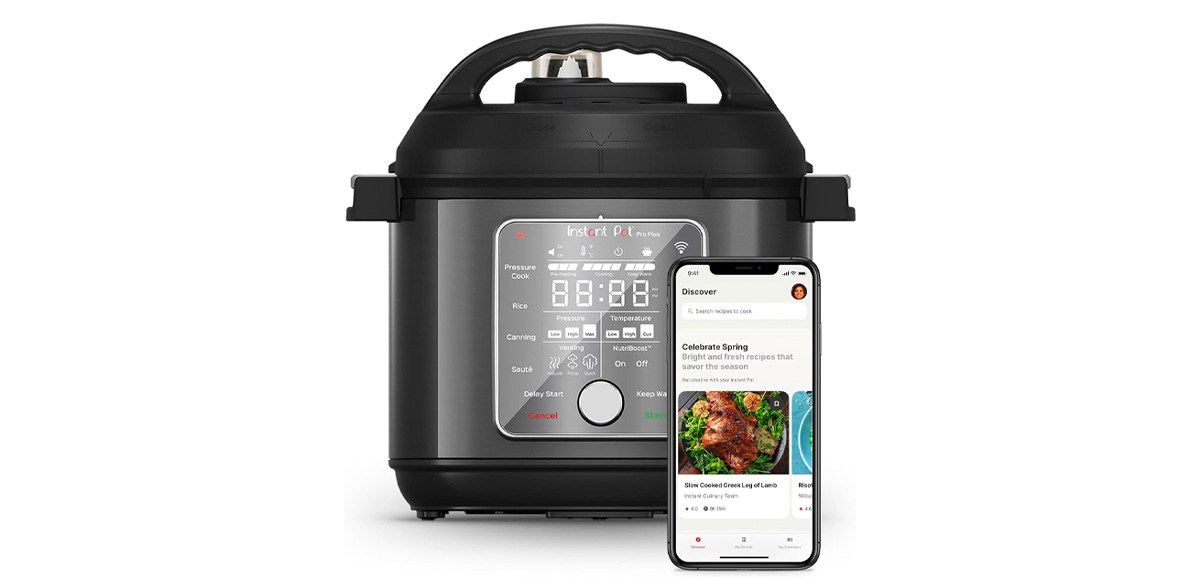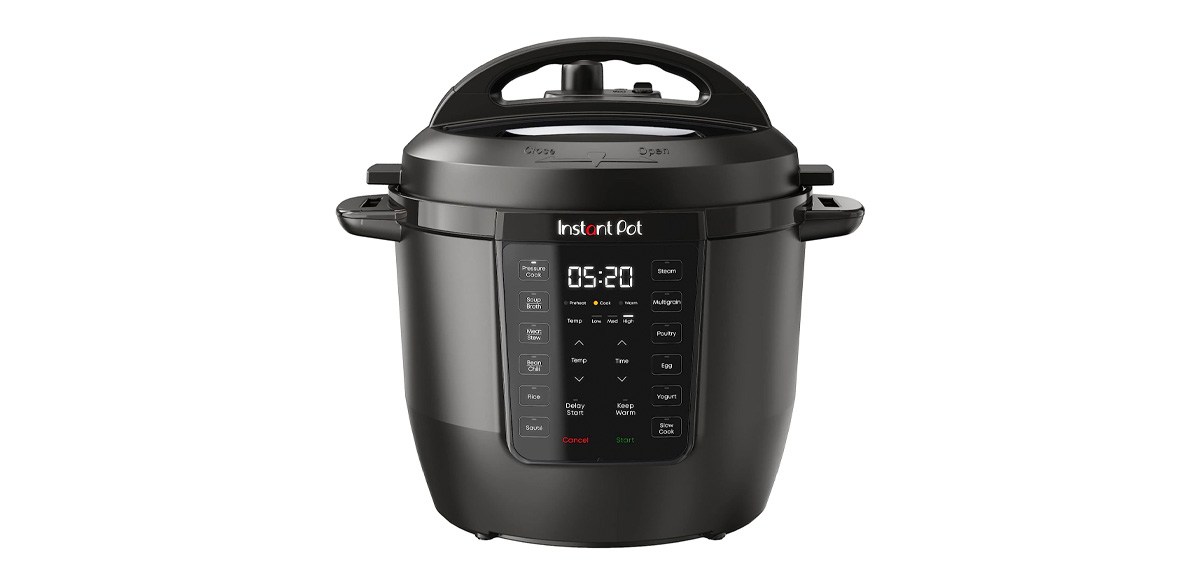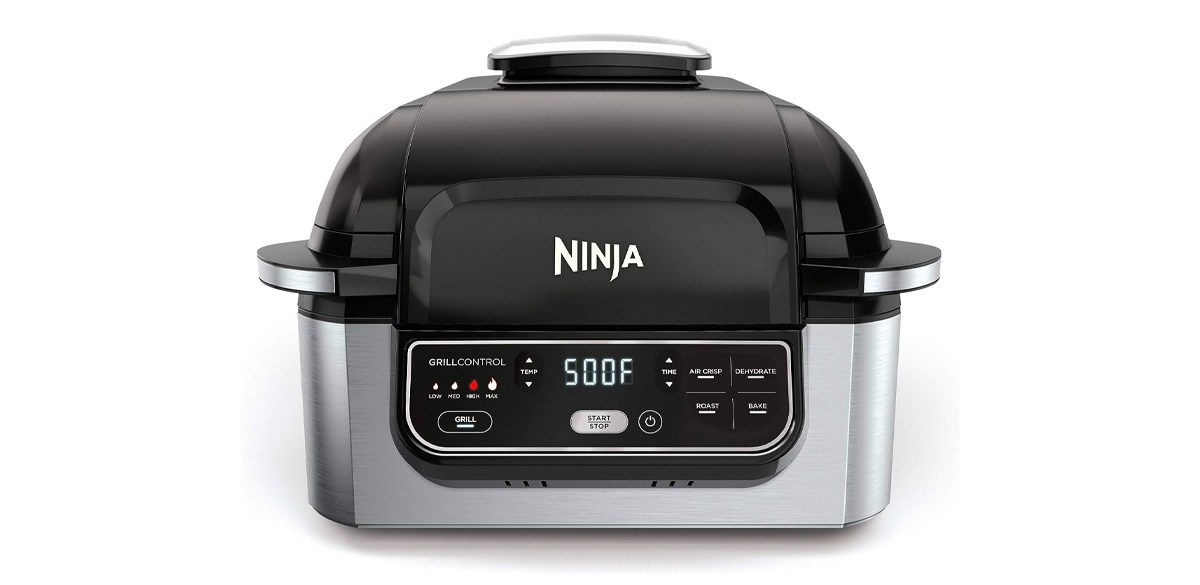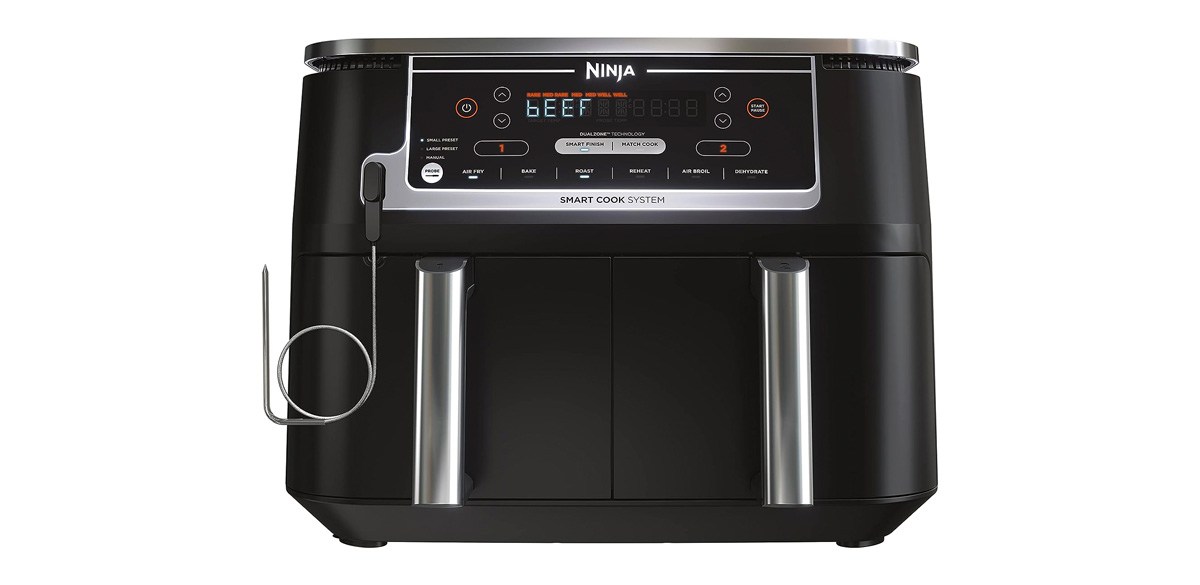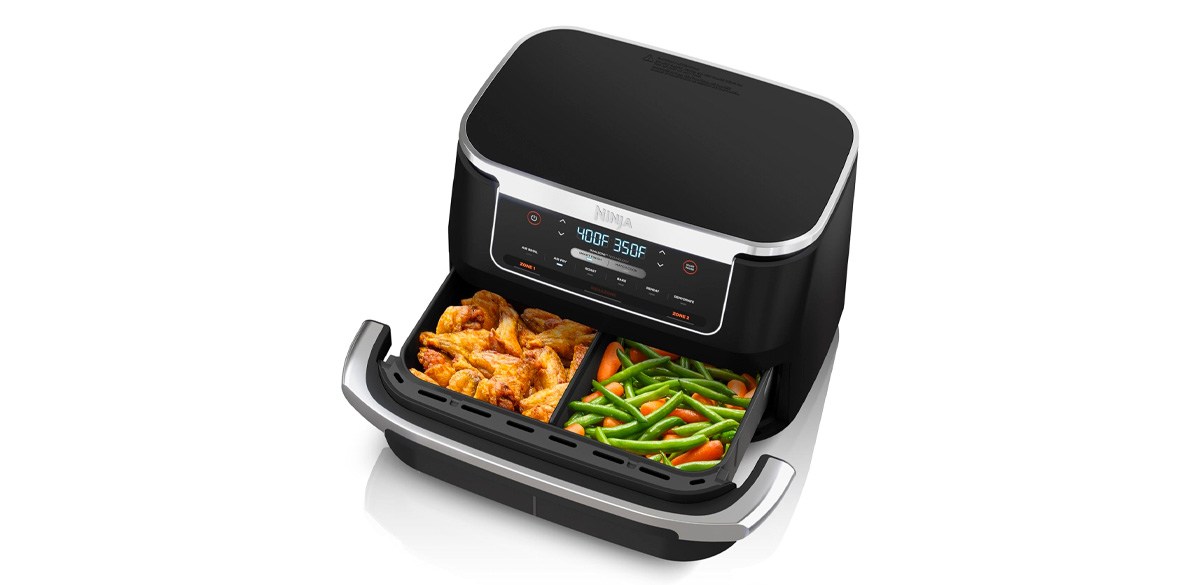Which of these versatile appliances is best?
Brands are fiercely competing for your attention. They manufacture products that are remarkably similar, at least at the concept level, to try to win a piece of your paycheck. Case in point: When you first look at two products, such as the Instant Pot Duo Crisp and the Ninja Foodi 12-in-1 Deluxe XL, they might seem like they do the same thing.
But depending on your needs, there is a clear winner when you compare them on a deeper level. The Ninja might be a tight fit beneath some cabinets and a little more expensive, but we give it high marks in almost every other category, making it our top choice.
To arrive at that conclusion, we tested each model and learned what it could do, how it did it and how well it did it. Then we compiled and evaluated the data to give us a definitive answer to which one was best.
Instant Pot pros and cons
Fast cooking times and versatility are some of the benefits offered by Instant Pot.
The Instant Pot is an electric pressure cooker. While it’s remarkably versatile, just like every other kitchen appliance, it has its share of pros and cons.
Pros
- Cooks fast: By increasing the pressure inside the cooking chamber, an Instant Pot can typically cook food in about one-third the time as other methods.
- It’s safe: Despite the increased internal pressure, which is about the same as a decently inflated soccer ball, the Instant Pot has 11 safety features to prevent catastrophes.
- It’s versatile: This Instant Pot gave us 11 cooking functions so we could choose how to cook our food.
- It let us forget about cooking: One of the best conveniences of the Instant Pot was that once it started, we could forget about it until our food was done. No stirring. No watching. Just waiting.
- Great for keeping food warm: The Instant Pot excels at keeping food warm for several hours if needed.
- It’s not messy: One important benefit of the sealed cooking pot is that there is no mess. Everything is contained and food cannot boil over.
Cons
- It only cooks fast: Yes, we could cook in roughly one-third the amount of time, but that didn’t include the pressurization. An Instant Pot takes about 15 minutes to reach the required internal pressure before you can start cooking
- There is a learning curve: While it is not difficult, for people who have never used a pressure cooker before, there is a learning curve.
- No checking the progress: There is no way to stop the cooking and check on progress. When the recipe is done, that’s when we found out if we did everything correctly.
Ninja Foodi pros and cons
No-mess cooking and keeping food warm are some of the benefits offered by the Ninja Foodi.
Just like the Instant Pot, the Ninja Foodi has pros and cons as well.
Pros
- Versatile: Not only can the Foodi pressure cook, air-fry and more, it can perform functions back-to-back so we could get chicken with a tender inside and a crispy exterior.
- Fast: Both the pressure cooking and the air-frying features saved us time when compared to traditional methods. In some instances, we could fully cook a dish in as little as half the time.
- Large capacity: With an 8-quart maximum capacity, we could cook enough food for the whole family in one batch.
- Intuitive operation: For basic operation, the Foodi had no learning curve. Using the appliance was completely intuitive.
- Consistent cooking: This air fryer features a solid design. Everything we made was uniformly cooked and tasty.
- Easy to clean: Thanks to Ninja’s ceramic coating, even food that looked cooked-on came right off with warm water and mild dish detergent.
Cons
- It has a hinged lid: This model had a hinged lid which, while convenient, meant we needed 21 inches of overhead space. Unfortunately, we couldn’t fit it beneath our cabinets.
- Bulky design: Although we wanted our pressure cooker to have a solid build, at 26 pounds, this could be troublesome for some people to move.
- Requires some trial and error: This model could dry out (or burn) food on the air-fry setting. We needed to monitor our first batches closely until we understood how quickly this model cooked.
- Loud operation: When the fan is on for air-frying, this model was comparable to running a small vacuum. The noise wasn’t a deal-breaker, but it’s not unnoticeable.
Instant Pot vs. Ninja Foodi: Similarities
Both the Instant Pot and Ninja are manufactured with built-in safety features.
On a high level, the Instant Pot Duo Crisp and the Ninja Foodi are very similar, as both appliances can cook with moist heat and dry heat. This allowed us to prepare food in a wide variety of ways. For example, both models could steam, saute, warm food, roast, air-fry, dehydrate and more. The Instant Pot and the Foodi each had a large 8-quart pot for pressure cooking with a smaller 5-quart basket that could be inserted for air-frying.
Also, it was obvious that both companies were concerned with user safety. Instant Pot and Ninja are manufactured with built-in safety features, such as overheat protection, a locking lid, stress-free venting and more. Lastly, both units had onboard controls, so it was simple to set parameters such as the cooking time and temperature.
Differences between Instant Pot and Ninja Foodi
Just because the Instant Pot and the Ninja Foodi are designed and built to do many of the same things, it doesn’t mean they are identical. For example, while both have an onboard control panel, the Ninja uses a dial for quick access to a wide range of parameters. On the Instant Pot, we had to raise or lower the parameters in increments by pressing a button.
The biggest difference between the two units is how the lids work. When pressure cooking, a securely sealing and locking lid is required for safety and optimum performance. When air-frying, easy access to food is preferred. The air-fry lid also contains the heating element and a fan. The Ninja uses a crisping lid that is permanently attached. It can be raised out of the way so the pressure cooking lid can be put in place. Instant Pot, on the other hand, uses two interchangeable lids. The problem we had with the Ninja was it did not fit beneath our cabinets.
When to use one vs. the other
In general, both models are versatile and offer a broad range of cooking options. The Instant Pot excels at moist-heat cooking. This meant we could use it for cooking rice, sous vide, slow-cooking proteins, making soups, keeping food warm, making yogurt and performing other similar tasks. We liked the Ninja better when making snack foods, such as french fries, or food that is best when it is extra crispy, like bacon. In short, when cooking with dry heat is preferred, we like the Ninja. Also, because of its nonstick coating, it’s quicker to clean and just better suited for potentially messy meals.
Pressure cooking vs. TenderCrisp technology: Which is healthier?
TenderCrisp technology is an additional step to add crispiness to food.
To consider which is healthier, first we need to understand the difference between pressure cooking and TenderCrisp technology. The first is a one-step process, while the second is a two-step process. And to be honest, step one is the same in both instances: we cooked a medium chicken (roughly 3.5 pounds) for 20 minutes at high pressure.
The difference with TenderCrisp technology is that after the chicken was cooked in the pressure cooker, we turned on the air-fry feature to give the chicken a quick blast of high heat for crisping. From a health perspective, high-heat cooking is not as desirable because it can destroy vitamins, and the process has been linked to certain carcinogens.
Cooking speed comparison
When we were using the same cooking function, the same temperatures, the same pressure setting and the same-size food portions, the cooking times were very similar. For example, a cup of white rice took four minutes in each model. However, when we started using different functions, we found it took roughly twice as long to air-fry in the Ninja when compared to pressure cooking it in the Instant Pot. However, the 15 minutes it takes a pressure cooker to preheat evened out the playing field a bit.
Versatility and cooking modes
Staying within the confines of comparing similar models, such as the Instant Pot Duo Crisp and the Ninja Foodi 12-in-1 Deluxe XL, the differences in versatility and cooking modes are minimal. Both models can pressure cook, air-fry, slow cook, steam, saute, keep warm, sous vide, broil, roast, bake and dehydrate. The Ninja also has a dedicated yogurt function.
User experience and interface
We could do everything from dehydrate to pressure cook with the Ninja Foodi.
The user interface on these two appliances is another area where they differ. While both models display time and temperature, each has a slightly different approach to setting these variables.
On the Instant Pot, there are 10 Smart Program options and eight Smart Program settings buttons. When we selected a Smart Program, it lit an LED, so we always knew which mode we were in. To change parameters, we had to press the “+” or “–” buttons to raise or lower the settings.
The Ninja has a slightly different way to operate the machine. There were three buttons — Temp, Function and Time — that let us select which mode we wanted to access. Once we were in the right mode, we could quickly zero in on specific parameters by twisting a dial. For our tastes, this method was a better design.
Other considerations
To help pinpoint which model is best for your needs, here are a few more factors to consider.
Price comparison
If price is important, the Instant Pot is a more affordable option. For instance, if you are debating whether to get the Instant Pot Duo Crisp or the Ninja Foodi 12-in-1 Deluxe XL, the Duo Crisp tends to run about $50 less — $199.95 compared to Ninja’s $249.99.
Convenience comparison
Although convenience is a matter of preference in some instances, we favor the Ninja’s design. For us, the user interface is faster and more intuitive — we prefer the quick-access dial to the tapping method of selecting parameters. When it comes to cleaning, while neither is difficult, the nonstick coating on the Ninja wins out. It only took about 10 minutes to get everything ready for our next use. The Instant Pot required a little more effort and took a few minutes longer to get the level of clean we desired.
The only part we don’t love about the Ninja is the hinged lid. This meant we couldn’t store and use the appliance under our cabinets because it took up too much overhead space to open. The Ninja also weighed about 4 pounds more, which wasn’t too bad, but, at 26 pounds, it requires a bit of upper-body strength to move.
Safety comparison
Frankly, the safety comparison was tougher than it should have been. While Instant was very forthcoming about its features — they were clearly listed in the owner’s manual — Ninja merely stated it had 14 safety features. When we dug deeper, we couldn’t find any specifics other than two mentions of a locking lid and directions for releasing steam. This isn’t to say these features don’t exist, but we weren’t fans of needing to work so hard to learn about safety. The Instant Pot, by comparison, lists all its safety features and even has an illustration that depicts regulators, sensors, a temperature monitor, a pressure controller, overheat protection, a locking lid and more.
Energy efficiency
Ninja states its Foodi 12-in-1 consumes 1,760 watts, while Instant Pot says its Duo Crisp only requires 1,500 watts. Depending on how often you use the appliance, it may only be a few cents to a dollar or two more to run the Ninja each month. The real problem with the Ninja is, at 1,760 watts, it sits right at that 1,800 max for a 15-amp circuit. If there is anything else on the same circuit, you risk popping the circuit breaker. If your home has 20-amp circuits, this will not be a major concern.
Warranty and customer service
Both brands offer a basic one-year limited warranty. This mostly protects the consumer from defects discovered or problems that arise within the first year of normal household use.
Customer service experiences can vary greatly depending on the individual you get when you contact the company. It is impossible to predict how adept this person will be at being able to troubleshoot and solve your particular issue. What we can quantify, however, is accessibility. Instant Pot has a live chat feature that is available 24/7. Ninja’s live chat more closely matches business hours: Monday through Friday from 9 a.m. to 9 p.m. ET and Saturday from 9 a.m. to 6 p.m. Both companies also offer phone support and have a list of frequently asked questions to help you solve problems on your own.
Top Instant Pot models
While we purposely kept this article focused on a head-to-head comparison of the Instant Pot Duo Crisp and the Ninja Foodi 12-in-1 Deluxe XL, Instant Pot makes other products that aren’t in direct competition with the 12-in-1 (because they have no crisping feature). However, these products are still high-quality items and they are worth mentioning.
Instant Pot Duo Plus
Product specifications
Dimensions: 15″ W x 15″ D x 14″ H | Capacity: 8 qt | Cooking functions: 9 | Max pressure: 15.23 psi | Power: 1,200 watts
When we needed to cook a large amount of food, we turned to the 8-quart capacity Instant Pot Duo Plus. We found this pressure cooker held enough food to feed at least six people, and it was simple to operate. The delayed-start feature came in handy for synchronizing our cooking, so everything was done at the same time. We appreciated the notched handle that accepted the lid, so we didn’t have to take up counter space.
Instant Pot Pro Plus
Product specifications
Dimensions: 13″ W x 13.2″ D x 12.7″ H | Capacity: 6 qt | Cooking functions: 10 | Max pressure: 15.23 psi | Power: 1500 watts
We liked that this app-controlled pressure cooker featured remote steam-venting, which helped reduce the workload of the busy at-home chef. Even though there is no crisping with this model, the 10 functions gave us a broad range of moist-heat cooking options. It also cooks at 20% higher power than other Instant Pots and features an intuitive touch and dial control panel that reminded us of the Ninja.
Instant Pot Rio
Product specifications
Dimensions: 12.2″ W x 13.2″ D x 12.5″ H | Capacity: 6 qt | Cooking functions: 7 | Max pressure: 15.23 psi | Power: 1000 watts
The Rio is an upgraded version of Instant Pot’s original Duo. It’s a basic pressure cooker with seven cooking functions. We appreciated the unit’s overall speed and consistency. It only took 12 minutes for the Rio to reach pressure when we cooked presoaked kidney beans. If you are looking for a reliable multicooker for under $100, this model impressed us with its emphasis on value.
Top Ninja Foodi models
Besides the 12-in-1 Deluxe XL, Ninja has a variety of other impressive models in its Foodi line. Here are the top three (note that none of these items has pressure-cooking capabilities).
Ninja Foodi 6-in-1 Indoor Grill and Air Fryer
Product specifications
Dimensions: 14.9″ W x 14.9″ D x 11.02″ H | Capacity: 6 qt | Cooking functions: 5 | Power: 1,760 watts
Ninja is really adept at creating appliances that fit specific needs. This indoor grill and air fryer is an excellent example. We love that it can reach 500 degrees and offer an authentic char-grill experience. We could take food from the freezer and have it fully cooked in roughly 25 minutes. The unit could also bake, roast and dehydrate.
Ninja Foodi 10-Quart 6-in-1 DualZone Smart XL Air Fryer
Product specificationsDimensions: 13.9″ W x 17.1″ D x 12.8″ H | Capacity: 10 qt | Cooking functions: 6 | Power: 1,690 watts
The DualZone feature that is built into this air fryer let us cook two different foods at two temperatures at the same time. Unlike other two-drawer units, we found this one made enough food in each drawer (5 quarts) to create a two-dish meal for four people. For instance, we could fit a 6-pound chicken in one drawer and 2 pounds of fries in the other.
Ninja Foodi 6-in-1 DualZone FlexBasket Air Fryer
Product specificationsDimensions: 11.81″ W x 18.19″ D x 11.26″ H | Capacity: 7 qt | Cooking functions: 6 | Power: 1,690 watts
This model had an interesting design. It featured one large 7-quart basket with a divider that could be inserted to create two small cooking chambers. The two chambers cook independently so users could make two items, such as hot dogs and french fries, at the same time.
How we analyzed
We use a multipronged approach to product reviews and head-to-head comparisons. During testing, we run products through a comprehensive series of tests calculated to determine a product’s strengths and weaknesses, and we evaluate their performance in real-world environments. To learn specifics, we study the manufacturer’s documents. And to keep individual biases from tainting the results, we consult with experts and consider other reviews. The data and conclusions in this article are the result of a team that wanted to provide useful, in-depth and objective information for the consumer who was interested in Instant Pot and/or Ninja products.
Should you buy an Instant Pot or a Ninja Foodi?
After an extensive evaluation of these products, we could make an argument for either, depending on your needs and preferences. The Instant Pot is more affordable, versatile and a quality product. It’s not a bad option if you favor cooking with moist heat and budget is a factor.
However, if we were buying just one appliance for our home, even though it is a little more expensive and we’d have to compromise on placement due to the hinged lid, our choice would be the Ninja Foodi 12-in-1 Deluxe XL. We prefer the user interface and actually like the heavier build — we’re not planning on moving it around the kitchen. It handles meats and snacks and dry-heat cooking exceptionally well, always offering consistent performance. And the nonstick coating makes it easy to clean.
Prices listed reflect time and date of publication and are subject to change.
Check out our Daily Deals for the best products at the best prices and sign up here to receive the BestReviews weekly newsletter full of shopping inspo and sales.
Copyright 2024 BestReviews, a Nexstar company. All rights reserved.


